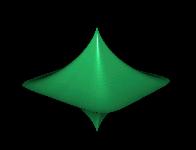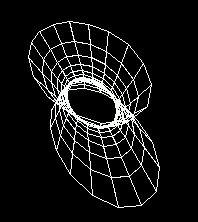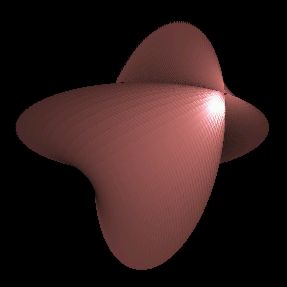Superquadrics
Andrew Skowronski, Jonathan Feldman
cs557 Project, McGill University
Introduction

Superquadrics are a flexible family of 3-dimensional parametric objects, useful
for geometric modeling. By adjusting a relatively few number of parameters, a
large variety of shapes may be obtained. A particularly attractive feature of
superquadrics is their simple mathematical representation.

Superquadrics can be divided into 4 parametric forms: superellipsoids,
one piece superhyperboloids, two piece super hyperboloids, and supertoroids.
In [Barr81], Alan Barr derives a set of
formulae for the representations,
normal vectors, tangent vectors, and inside-outside functions of each of
these forms. We took this mathematical definition of superquadrics
and implemented C++ classes for drawing superquadrics efficiently
in OpenGL. Then, to demonstrate our library we wrote 3 demonstration
programs. Using these programs it is possible to get a very good
idea about how rich a class of 3D objects the superquadric family
defines.

Our project is divided into three main sections: theory, implementation,
and applications. The theory section presents
and discusses Barr's formulae related to superquadrics. The
implementation section discusses
our implementation of superquadrics in C++ and OpenGL. The
applications section describes a number of
uses for superquadrics in academic research.
Contents
References
[Barr81] Barr, A.H. (1981) Superquadrics and Angle-Preserving
Transformations. IEEE Computer Graphics and Applications,
1, 11-22.
[Ferr93] Ferrie, F.P., Lagarde, J., & Whaite, P. (1993) Darboux Frames,
Snakes, and Super-Quadrics: Geometry from the Bottom Up.
IEEE Transactions on Pattern Analysis and Machine Intelligence
15(8), 771-783.
[Terz91] Terzopoulos, D. (1991) Dynamic 3D Models with Local and
Global Deformations: Deformable Superquadrics. IEEE
Transactions on Pattern Analysis and Machine Intelligence,
13(7), 703-714.
Note: All the graphics in this paper were generated by the
demonstration programs that we wrote as part of the project.


This project was created by Andrew
"Terminator" Skowronski and
Jonathan "The Punisher" Feldman
.
Last updated on 4/14/96


